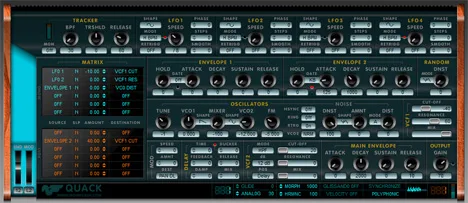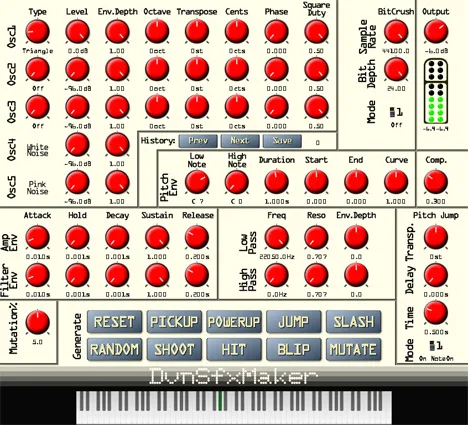Quack Synthesizer by novaflash: Deep Sound Modeling in Your Hands
In the world of software synthesizers, new instruments constantly emerge, offering unique possibilities for music creation and sound design. Among them, Quack, a VST instrument from developer novaflash, holds a special place. This synthesizer stands out due to its powerful architecture focused on deep modulation and sound experimentation, making it attractive to both experienced sound designers and musicians seeking new timbral palettes.
What Makes Quack Special? The Synthesizer’s Architecture
At the core of Quack lies the concept of a modular matrix, which is the central element of its sound-generating capabilities. This is not just another virtual analog or a simple subtractive synthesizer. Quack offers an extended set of tools for sound generation and shaping that can be linked together in non-trivial ways. This approach opens up wide horizons for creating complex, moving, and unique timbres that go beyond standard capabilities.
Let’s consider the key components that form the Quack sound engine:
- Two Oscillators with a Rich Waveform Collection: The plugin is equipped with two independent oscillators. Each offers a choice of 17 different waveforms. This large number of basic waveforms allows you to start sound design from very different starting points – from the classic sine, saw, and square to more exotic and complex forms. Combining these oscillators and choosing different waveforms for each of them is the first step towards creating a unique timbre.
- Noise Oscillator: In addition to the tonal oscillators, Quack has a specialized noise generator. Noise is an important element in sound design, allowing you to add texture, “air,” imitate percussive sounds, or create effects (e.g., vinyl noise or atmospheres). Its integration expands the possibilities of synthesis, allowing you to go beyond purely melodic sounds.
Powerful Modulation and Dynamic Control Tools
The true power of Quack is revealed through its flexible modulation system:
- Four LFOs with 17 Waveforms Each: The presence of as many as four low-frequency oscillators (LFOs) is one of Quack’s strongest points. Each LFO, like the oscillators, offers a choice of 17 waveforms. This means you can create extremely complex and independent movements for different synthesizer parameters. Four LFOs can work at different speeds, with different shapes, and be applied to different targets simultaneously – this allows you to create multi-level rhythmic patterns, constantly changing timbres, phaser, flanger, or wah-wah effects with high detail.
- Two Envelopes: Two envelope generators (e.g., ADSR type or similar) are used to shape the dynamics of the sound. Typically, one envelope controls the volume (amplitude), and the other can be assigned to modulate other parameters – filter cutoff frequency, pitch, effect parameters, etc. The presence of two independent envelopes gives you more control over how the sound evolves over time.
- Modulation Matrix: This is undoubtedly the heart of Quack. The modulation matrix allows you to freely assign any modulation source (LFOs, envelopes, MIDI messages) to any available synthesizer parameter (oscillator pitch, cutoff frequency, resonance, intensity of other modulations, etc.). This is where the magic happens – you can create unexpected connections, experiment with cross-modulation, and get sounds that would be impossible on synthesizers with a fixed architecture. The matrix opens the space for endless creative exploration.
Additional Features for Creativity and Convenience
- Preset Morphing: This function allows you to smoothly transition between two different synthesizer presets. This is extremely useful for creating dynamic changes in a track, performing live sets, or creating complex sound transitions. Instead of a sharp change in sound, morphing provides an organic evolution of the timbre.
- MIDI Learning: The MIDI Learning function allows you to easily link any Quack interface parameter to a knob, fader, or button on your MIDI controller. This significantly improves the workflow, making the synthesizer more interactive and convenient for playing and automation.
Who Is This Plugin For?
Quack is ideal for:
- Musicians and producers working in electronic music genres (techno, house, ambient, drum and bass, etc.), where complex and moving timbres are key.
- Sound designers looking for a flexible tool to create unique sound effects, atmospheres, or textures for games, films, or other media projects.
- Sound experimenters who like to delve into the subtleties of synthesis and discover new soundscapes through modulation.
Conclusions
Quack by novaflash is more than just a free synthesizer. It’s a powerful tool for deep sound modeling, which, thanks to its flexible modular matrix and rich set of oscillators and LFOs, allows you to create truly unique and complex sounds. If you are looking for a synthesizer that can do much more than basic timbres and are ready to experiment with modulation, Quack definitely deserves your attention. It proves that high-quality and functional tools can be accessible to everyone.



